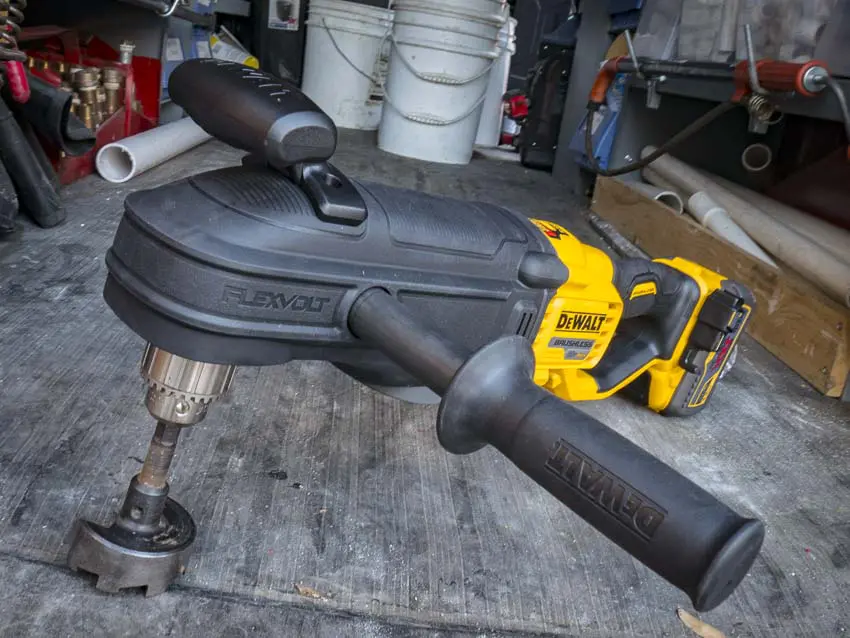DeWalt FlexVolt In-Line Stud and Joist Drill Packs Powerful Performance
The DeWalt FlexVolt In-Line Stud and Joist Drill shifts from its original form to a more elongated design to fit in tighter spaces. Despite the market’s insistence on calling this a DeWalt Hole Hawg, that’s really a Milwaukee name, but the designs are very similar for this model. The obvious comparison is between the new DeWalt DCD470 and the Milwaukee M18 Fuel Super Hawg – we’ll take a look at them in both performance and design.
Pros
- Power and weight make quick work of even the deepest holes
- DeWalt’s E-Clutch protects you in bind-ups
- Two variable speed ranges (0-400/ 0-1320 rpm) and Quick-Shift Speed Selector
- Tool Connect-ready for location tracking
- Reversible handle lets you get into tighter spots when you need and hold right above the chuck when you don’t
Cons
- More expensive than what you get from Milwaukee and Makita
- Taller head doesn’t get into as tight a space as Milwaukee
Performance
Shivering Timbers
Piping holes through wooden structural members for repipes, remodels, and new construction: that’s how we use the DeWalt FlexVolt In-Line Stud and Joist Drill. You almost hear the timbers shiver when we bring the drill out. This thing will bore through anything in its path, no matter how thick.

A triple top cap, roughly 4.5 inches thick, is the typical limit of what I ask the DeWalt DCD470 to do. It accomplishes that with such ease that I bet it can handle as deep a hole as you have bit length.
Clutch Performance
Many guys use a traditional, corded drill for this kind of work. I should know – I was one of them before I stepped up to the Milwaukee Super Hawg a couple of years ago.
The danger, of course, is a bind-up. But the DeWalt hole hawg’s E-Clutch system works flawlessly by catching bind-ups and shutting the tool down before I ever reach harm’s way. The drill’s variable speed makes it easy to avoid a bind-up, but it can still happen. When the E-Clutch engages, the red light on top of the drill kicks on. That way you know the drill’s not spinning due to the E-Clutch and not because the battery is dead.

In addition to the traditional drill’s bind-up danger, you’ve got the pain-in-the-neck issue of dragging a 100-foot cord through an attic. We have a fairly cordless jobsite nowadays, but I still remember that annoyance. So the DeWalt FlexVolt In-Line Stud and Joist Drill’s cordless, beastly power is still notable.

The Big DeWalt DCD470 Deal
DeWalt’s biggest issue with their design is the total height of the powerhead compared to Milwaukee. You can take the top handle off and flip it to give you more clearance. That helps, but it’s still about 1.5″ taller from chuck to top than Milwaukee’s Super Hawg.

If you need to drill through the top plate of a wall near the soffit, you’re out of luck in most cases. I even tried it in an attic with a steep roof and couldn’t get enough clearance.
Similarly, the powerhead is so tall with the handle that drilling a hole close to the intersection of a ceiling joist and strut is challenging. If you can make it work, you have to go in at an angle. That’s only a viable strategy only when there’s a single top plate. Anything thicker is a problem.
In a recent remodel, I drilled holes through 2x studs against the unfinished side of the wall. Here, the powerhead’s length out from the chuck makes it tricky to go into the stud at 90º and on center. There’s no problem with less common 2x6s, but you’ll need to pivot the drill down to get into 2x.

That’s not to say that Milwaukee’s design is perfect. It just gives you that little bit of extra clearance to reach a few more places than you can with this.
More Muscle for New Construction
The DeWalt FlexVolt In-Line Stud and Joist Drill is an absolute beast for new construction. When you have the room, I doubt there’s a more powerful, faster option. But you’ll have to decide if the increased power justifies the size over the Super Hawg or even the Makita XAD03 for your work.

One other thought – you can slide a relatively small Milwaukee battery into the Super Hawg in a pinch, but the smallest FlexVolt you can use with this DeWalt hole hawg is a fairly large 6Ah. With that handle and battery, the tool weighs in at 18.4 pounds. That’s about 4 pounds heavier than the Super Hawg and I really notice it when I have to drill above shoulder height.
Additional Features
Speeds
The first variable speed range is 0-400 RPM while the second is 0-1320. Chances are that I’ll do most of my work in the low range. The switch has an unusual placement on the bottom of the tool rather than the top.

Tool Connect Tag Ready
DeWalt’s Tool Connect offers some peace of mind for tracking and locating expensive/critical tools. You’ll need to install a Tool Connect Tag (sold separately) – it’s probably a good tool insurance policy.
Price
DeWalt’s FlexVolt system is exceptionally capable. If you’re already on the platform, the bare DCD470 will set you back $399. If you’re not – or you could use another battery – the kit is $560. Here how it stacks up:
- Milwaukee M18 Fuel Super Hawg (with or without Quik-Lok chuck)
- $349 bare
- $549 2 x 5.0 Ah kit (180 watt-hours)
- $649 2 x 9.0 Ah kit (324 watt-hours)
- Makita XAD03
- $359 bare
- $469 2 x 5.0 Ah kit (180 watt-hours)
- DeWalt FlexVolt In-Line Stud and Joist Drill
- $360 bare
- $579 9.0Ah kit (162 watt-hours)
If you’re already using the FlexVolt platform, adding the bare tool or an extra battery with the kit is definitely the way to go. But if you’re not, Makita sits real pretty in the value category and Milwaukee’s 2 x 9.0 Ah kit gives you a ton of battery capacity for the price. Where DeWalt is going to rise above the other two is with sheer power. If that’s your biggest priority, the DeWalt hole hawg is the way to go.
The Bottom Line
You won’t find a more muscular right angle drill than the DeWalt 60V Max In-Line Stud and Joist Drill – it just demolishes holes. But all that strength comes with a cost in size: it can’t fit in tighter spaces. That makes it hard to perform complete repipes in tight spaces like attics. But for new construction, it’s the top dog.
DeWalt FlexVolt In-Line Stud and Joist Drill Specifications
- Item Numbers:
- DCD470B (Bare)
- DCD470X1 (Kit)
- No-Load Speed: 0 – 400/0 – 1320 RPM
- Height: 6.95 inches
- Length: 21.3 inches
- Weight: 14.2 pounds bare, 15.2 pounds with handle, 18.4 pounds with handle and battery
- Prices:
- DCD470B (Bare): $360
- DCD470X1 (Kit): $579



